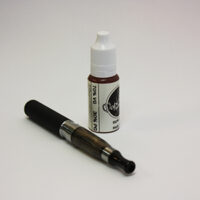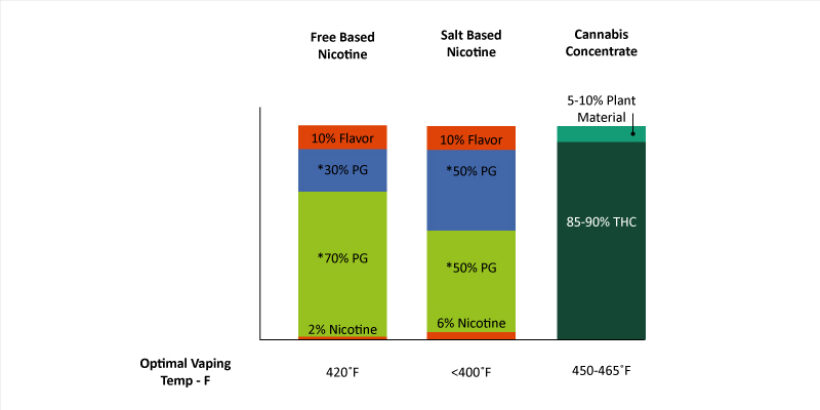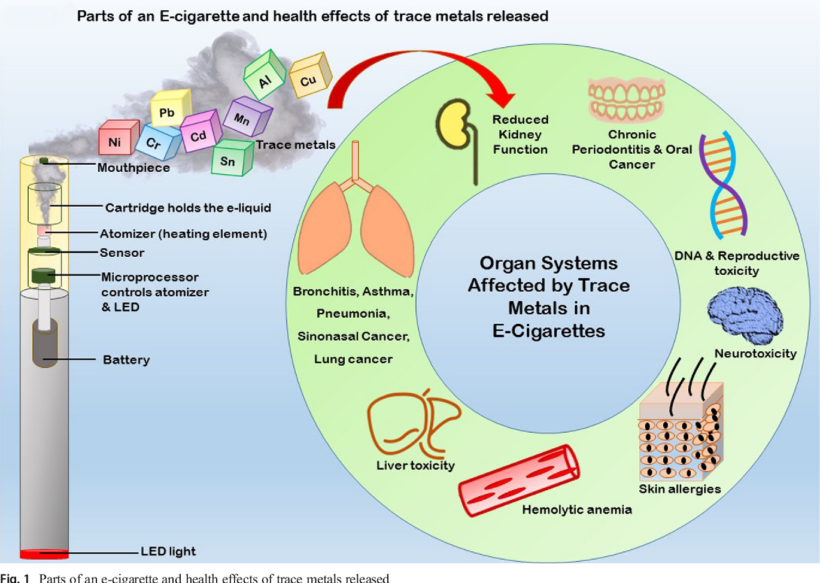
Vaping 101: What Are These Things and What’s in Them?
By Jared O’Connor, MPH, Public Health & Outreach Specialist / Washington Poison Center
With the CDC reporting 1,888 lung injury cases and 34 deaths (as of Oct. 29, 2019) associated with e-cigarette use or vaping products, there have been many questions about the products’ safety. To date, no one substance, chemical or device has been found to be present in all cases. The CDC surveillance is primarily focused on acute cases and little is known about the potential results of long-term chronic exposure to these devices.
Devices
There are many different devices and formulations available in the market.
Nicotine Devices

E-cigarette
Generally refers to a one-time use, disposal device. Often made to resemble a cigarette and referred to as first-generation devices.

Vape pen
These are rechargeable and refillable. When the battery runs low, they can be charged using a cell phone charger. When they run out of liquid, they can be refilled by purchasing E-liquids. These are often referred to as second-generation devices.

Mods or tanks
These devices differ from vape pens as they have several heating elements present, allowing a higher volume of aerosol to be emitted. This requires the device to be much larger than a vape pen to accommodate a large atomizer, several batteries and processor. They allow customization of volume and temperature. These are often referred to as third-generation devices.

Salt-based nicotine devices
Salt-based nicotine is more acidic and closer to the human body’s natural PH of 7.35-7.45, reducing the throat burn that may be associated with free-based nicotine devices. Typical salt-based formulations have up to three times the nicotine concentration of typical free-based formulations.
JUUL: A small and discreet device that utilizes refillable pods that contain E-liquid. Since the nicotine present is much more concentrated, less aerosol volume is needed to deliver a comparable amount of nicotine to the user. This, combined with the popular fruit flavors available, led to the devices being extremely popular in the adolescent population. Often referred to as fourth-generation devices.
Refillable salt-based devices: Often referred to as “Pod Mods,” these devices come in many shapes and sizes. They are typically very small like the JUUL, but do not require the user to buy pods. Instead, these devices utilize a “pod” or reservoir that can be refilled using salt-based E-liquids that are purchased in large quantities. Often referred to as fourth-generation devices.
Cannabis Devices
Plant material devices: These devices allow users to vaporize plant materials that are typically combusted. THC levels can vary from 5 percent to 20 percent depending on the product.
BHO concentrate devices: These devices utilize butane hash oil (BHO), which is a concentrated form of cannabis. BHO is created by heating up hash to a high temperature and then using the solvent, butane, to separate the THC from the plant material. This is the most popular form of concentrate in our market due to the ease of manufacture and cost. THC levels are typically between 50 percent to 95 percent pure THC, with higher levels being more popular.
CO2 Oil or THC Oil Devices: These devices utilize CO2 oil, which is a concentrated form of cannabis. Because of health concerns regarding butane residue in BHO, many people are now choosing this more expensive alternative for vaping. THC levels are typically between 50 percent to 95 percent pure THC, with higher levels often more popular.
Types of Cannibis

*Important note: Due to its ease of manufacture, BHO is typically the form of concentrate seen in states where cannabis is illegal. BHO is typically a solid at room temperatures and therefore does not diffuse easily in a liquid form. Many of the CDC’s acute cases are from THC products. It is unknown if in some instances users are using other substances such as vitamin E to help emulsify the solid BHO so that it can be used in a liquid.
What is in the Vapor?
First, it is important to note there is no “vapor” emitted by vaping devices. This is a common misconception due to the term “vaping” being used, which misleads the general public into thinking that the devices emit harmless water vapor. Instead, the devices produce an aerosol of ultrafine particles (UFP). Toxic chemicals attached to UFPs may have greater adverse health effects than toxins that are attached to larger tobacco smoke products, as UFP penetrate deeper into the lungs and more effectively deliver attached substances such as nicotine to the bloodstream.

Further, it is important to note that E-liquids are completely unregulated. Neither the Food and Drug Administration nor any other agency regulates which ingredients are present in these liquids. Shops that are selling E-liquids can add any substance they want to the product destined for the user, and the consumer has no way of knowing what exactly is in these products, even if there is a label with a list of ingredients. Ingredients are typically bought online from various manufacturers, many of them located in foreign countries such as China, and then sent to the vape shops where they are mixed and put on the shelves for consumption.
E-liquids or E-juices are typically composed of these four ingredients:
- Vegetable glycerin (VG)
- Propylene glycol (PG)
- Nicotine
- Flavoring - can be a multitude of chemicals

Adapted from the Washington Poison Center
Known Substances of Concern in Aerosols
Nicotine: Highly addictive, harms brain development in adolescence.
Toxic metals: (lead, arsenic, cadmium, chromium, tin, nickel, manganese, lithium, etc.): Damage the lungs, liver and brain; linked to cancer. Metals present and concentrations tend to vary from device to device. Devices tend to emit more toxic metals when the atomizer is new.

© 2019 Gaur S, Agnihotri R
Silicon: Dominant metalloid found in aerosols. Inert, but known to cause silicosis when inhaled in industrial settings. Primarily found in the wick of vaping devices.
Flavorings: A multitude of chemicals can be present. Some concerning substances:
- Diketones
- Diacetyl: causes bronchitis obliterans or “popcorn lung” and is FDA-approved for ingestion, but not inhalation.
- Acetyl propionyl (aka pentane-2,3, dione): irritant.
- Acetoin: carcinogen and irritant.
- Pulegone: carcinogen.
- Mixing flavors leads to greater cytotoxicity and spontaneous creation of other harmful chemicals.
Propylene glycol: Causes respiratory irritation, linked to asthma development in children; heating may produce small amounts of known carcinogens such as formaldehyde.
Volatile organic chemicals: Benzene, ethylene oxide, acrylonitrile, acrolein and acrylamide—irritants and carcinogenic.
Free radicals: cause cellular damage and are carcinogens.
Known Correlated Health Effects
There is presently no direct causation pathway established between any chemical or vaping device and specific diseases or injury. However, recent studies have investigated the correlations between known diseases and vaping and demonstrate the following:
- 71 percent increased risk of stroke
- 56 percent increased risk of heart attack
- 44 percent increased risk of heart disease
- 50 percent increased risk of asthma attacks in teens exposed to secondhand vapor
A 2018 study demonstrated that vaping inhibited alveolar macrophages and other phagocytes in the lungs resulting in impaired immune clearance of bacteria and other particles, increasing inflammatory response to infections or irritants.
Further, a 2019 study utilizing mice as test subjects, showed concerning health effects when exposing the mice to e-cigarette vapors. The studies demonstrated the following:
- Mice exposed to e-cigarette vapors for 54 weeks sustained extensive DNA damage and:
- 57.5 percent developed bladder cancer
- 22.5 percent developed lung cancer
References
“Outbreak of Lung Injury Associated with the Use of E-Cigarette, or Vaping, Products,” Centers for Disease Control and Prevention, October 24, 2019, Centers for Disease Control and Prevention
Williams M, Bozhilov K, Ghai S, Talbot P (2017) Elements including metals in the atomizer and aerosol of disposable electronic cigarettes and electronic hookahs. PLoS ONE 12(4): e0175430. Public Library of Science Journal
Gaur S, Agnihotri R. Health Effects of Trace Metals in Electronic Cigarette Aerosols-a Systematic Review. Biol Trace Elem Res. 2019 Apr;188(2):295-315. doi: 10.1007/s12011-018-1423-x. Epub 2018 Jul 4. PubMed PMID: 29974385.
Allen, J. G., Flanigan, S. S., LeBlanc, M., Vallarino, J., MacNaughton, P., Stewart, J. H., & Christiani, D. C. (2016). Flavoring Chemicals in E-Cigarettes: Diacetyl, 2,3-Pentanedione, and Acetoin in a Sample of 51 Products, Including Fruit-, Candy-, and Cocktail-Flavored E-Cigarettes. Environmental health perspectives, 124(6), 733–739. doi:10.1289/ehp.1510185
Rubinstein, Mark & Delucchi, Kevin & Benowitz, Neal & Ramo, Danielle. (2018). Adolescent Exposure to Toxic Volatile Organic Chemicals From E-Cigarettes. Pediatrics. 141. e20173557. 10.1542/peds.2017-3557.
Ndunda PM, Muutu TM. Electronic cigarette use is associated with a higher risk of stroke. International Stroke Conference 2019 Oral Abstracts. Community/risk factors, Abstract 9. Stroke. 2019; 50:A9. Available at: American Heart Association, Accessed February 8, 2019.
Chapman, D. G., Casey, D. T., Ather, J. L., Aliyeva, M., Daphtary, N., Lahue, K. G., … Irvin, C. G. (2019). The Effect of Flavored E-cigarettes on Murine Allergic Airways Disease. Scientific reports, 9(1), 13671. doi:10.1038/s41598-019-50223-y
Scott A, Lugg ST, Aldridge K, et al. Pro-inflammatory effects of e-cigarette vapour condensate on human alveolar macrophages. [published online August 13, 2018]. Thorax. doi: 10.1136/thoraxjnl-2018-211663.
Moon-shong Tang, Xue-Ru Wu, Hyun-Wook Lee, Yong Xia, Fang-Ming Deng, Andre L. Moreira, Lung-Chi Chen, William C. Huang, Herbert Lepor (2019) Electronic-cigarette smoke induces lung adenocarcinoma and bladder urothelial hyperplasia in mice-Proceedings of the National Academy of Sciences Oct 2019, 201911321; DOI: 10.1073/pnas.1911321116
